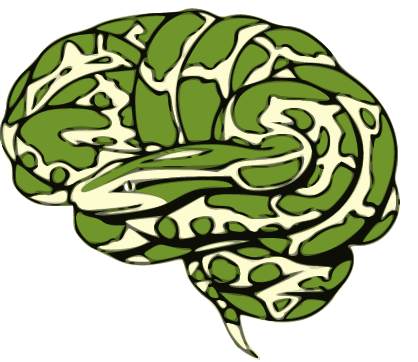Create interfaces¶
This section is meant for the more advanced user. In it we will discuss how you can create your own interface, i.e. wrapping your own code, so that you can use it with Nipype.
In this notebook we will show you:
Example of an already implemented interface
What are the main parts of a Nipype interface?
How to wrap a CommandLine interface?
How to wrap a Python interface?
How to wrap a MATLAB interface?
But before we can start, let’s recap again the difference between interfaces and workflows.
Interfaces vs. Workflows¶
Interfaces are the building blocks that solve well-defined tasks. We solve more complex tasks by combining interfaces with workflows:
| Interfaces | Workflows |
|---|---|
| Wrap *unitary* tasks | Wrap *meta*-tasks
|
| Keep track of the inputs and outputs, and check their expected types | Do not have inputs/outputs, but expose them from the interfaces wrapped inside |
| Do not cache results (unless you use [interface caching](advanced_interfaces_caching.ipynb)) | Cache results |
| Run by a nipype plugin | Run by a nipype plugin |
Example of an already implemented interface¶
For this notebook, we’ll work on the following T1-weighted dataset located in /data/ds000114/sub-01/ses-test/anat/sub-01_ses-test_T1w.nii.gz:
from nilearn.plotting import plot_anat
%matplotlib inline
plot_anat('/data/ds000114/sub-01/ses-test/anat/sub-01_ses-test_T1w.nii.gz', dim=-1);
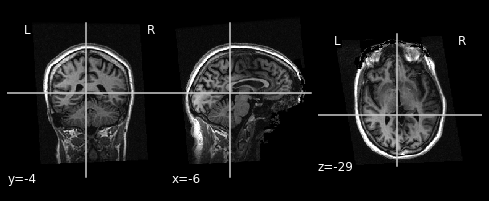
Example of interface: FSL’s BET¶
Nipype offers a series of Python interfaces to various external packages (e.g. FSL, SPM or FreeSurfer) even if they themselves are written in programming languages other than python. Such interfaces know what sort of options their corresponding tool has and how to execute it.
To illustrate why interfaces are so useful, let’s have a look at the brain extraction algorithm BET from FSL. Once in its original framework and once in the Nipype framework.
The tool can be run directly in a bash shell using the following command line:
%%bash
bet /data/ds000114/sub-01/ses-test/anat/sub-01_ses-test_T1w.nii.gz \
/data/ds000114/sub-01/ses-test/anat/sub-01_ses-test_T1w_bet.nii.gz
… which yields the following:
plot_anat('/data/ds000114/sub-01/ses-test/anat/sub-01_ses-test_T1w_bet.nii.gz', dim=-1);
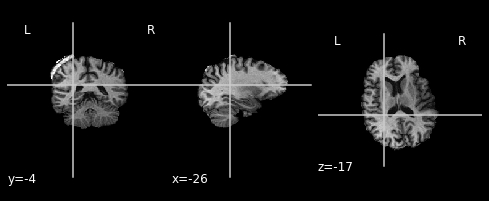
Using nipype, the equivalent is a bit more verbose:
line 1: The first line imports the interface
line 2: Then, the interface is instantiated. We provide here the input file.
line 3: Finally, we run the interface
line 4: The output file name can be automatically handled by nipype, and we will use that feature here
from nipype.interfaces.fsl import BET
skullstrip = BET(in_file='/data/ds000114/sub-01/ses-test/anat/sub-01_ses-test_T1w.nii.gz')
res = skullstrip.run()
print(res.outputs.out_file)
/home/neuro/workshop_weizmann/workshop/nipype/notebooks/sub-01_ses-test_T1w_brain.nii.gz
Now we can verify that the result is exactly the same as before. Please note that, since we are using a Python environment, we use the result of the execution to point our plot_anat function to the output image of running BET:
plot_anat(res.outputs.out_file, dim=-1);
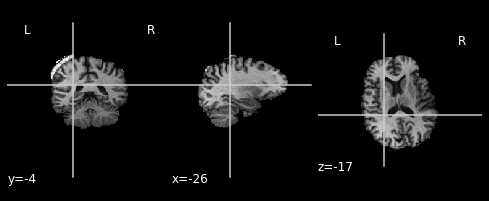
What are the main parts of a Nipype interface?¶
Nipype is designed to ease writing interfaces for new software. Nipype interfaces are designed with three elements that are intuitive:
A specification of inputs (or the
InputSpec)A specification of outputs (or the
OutputSpec)An interface core which implements the
run()method we’ve seen before for BET, and which puts together inputs and outputs.
The CommandLine interface¶
A quick example¶
The easiest and quickest way to run any command line is the CommandLine interface, which has a very simple specification of inputs ready to use:
from nipype.interfaces.base import CommandLine
CommandLine.help()
Implements functionality to interact with command line programs
class must be instantiated with a command argument
Parameters
----------
command : str
define base immutable `command` you wish to run
args : str, optional
optional arguments passed to base `command`
Examples
--------
>>> import pprint
>>> from nipype.interfaces.base import CommandLine
>>> cli = CommandLine(command='ls', environ={'DISPLAY': ':1'})
>>> cli.inputs.args = '-al'
>>> cli.cmdline
'ls -al'
>>> # Use get_traitsfree() to check all inputs set
>>> pprint.pprint(cli.inputs.get_traitsfree()) # doctest:
{'args': '-al',
'environ': {'DISPLAY': ':1'}}
>>> cli.inputs.get_hashval()[0][0]
('args', '-al')
>>> cli.inputs.get_hashval()[1]
'11c37f97649cd61627f4afe5136af8c0'
Inputs::
[Optional]
args: (a string)
Additional parameters to the command
argument: ``%s``
environ: (a dictionary with keys which are a bytes or None or a value
of class 'str' and with values which are a bytes or None or a
value of class 'str', nipype default value: {})
Environment variables
Outputs::
None
As a quick example, let’s wrap bash’s ls with Nipype:
nipype_ls = CommandLine('ls', args='-lh', terminal_output='allatonce')
Now, we have a Python object nipype_ls that is a runnable nipype interface. After execution, Nipype interface returns a result object. We can retrieve the output of our ls invocation from the result.runtime property:
result = nipype_ls.run()
print(result.runtime.stdout)
total 3.0M
-rw-rw-r-- 1 neuro users 6.0K Oct 14 12:54 advanced_aws.ipynb
-rw-rw-r-- 1 neuro users 48K Oct 14 12:54 advanced_create_interfaces.ipynb
-rw-rw-r-- 1 neuro users 9.1K Oct 14 12:54 advanced_interfaces_caching.ipynb
-rw-rw-r-- 1 neuro users 1.5K Oct 14 12:54 advanced_mipav.ipynb
-rw-rw-r-- 1 neuro users 1.1K Oct 14 12:54 advanced_nipypecli.ipynb
-rw-rw-r-- 1 neuro users 5.6K Oct 14 12:54 advanced_sphinx_ext.ipynb
-rw-rw-r-- 1 neuro users 2.1K Oct 14 12:54 advanced_spmmcr.ipynb
-rw-rw-r-- 1 neuro users 14K Oct 14 12:54 basic_data_input_bids.ipynb
-rw-rw-r-- 1 neuro users 28K Oct 14 12:54 basic_data_input.ipynb
-rw-rw-r-- 1 neuro users 19K Oct 14 12:54 basic_data_output.ipynb
-rw-rw-r-- 1 neuro users 4.1K Oct 14 12:54 basic_debug.ipynb
-rw-rw-r-- 1 neuro users 21K Oct 14 12:54 basic_error_and_crashes.ipynb
-rw-rw-r-- 1 neuro users 17K Oct 14 12:54 basic_execution_configuration.ipynb
-rw-rw-r-- 1 neuro users 9.1K Oct 14 12:54 basic_function_interface.ipynb
-rw-rw-r-- 1 neuro users 11K Oct 14 12:54 basic_graph_visualization.ipynb
-rw-rw-r-- 1 neuro users 9.2K Oct 14 12:54 basic_import_workflows.ipynb
-rw-rw-r-- 1 neuro users 25K Oct 14 12:54 basic_interfaces.ipynb
-rw-rw-r-- 1 neuro users 12K Oct 14 12:54 basic_iteration.ipynb
-rw-rw-r-- 1 neuro users 19K Oct 14 12:54 basic_joinnodes.ipynb
-rw-rw-r-- 1 neuro users 13K Oct 14 12:54 basic_mapnodes.ipynb
-rw-rw-r-- 1 neuro users 7.6K Oct 14 12:54 basic_model_specification_fmri.ipynb
-rw-rw-r-- 1 neuro users 9.6K Oct 14 12:54 basic_nodes.ipynb
-rw-rw-r-- 1 neuro users 17K Oct 14 12:54 basic_plugins.ipynb
-rw-rw-r-- 1 neuro users 34K Oct 14 12:54 basic_workflow.ipynb
-rw-rw-r-- 1 neuro users 24K Oct 14 12:54 example_1stlevel.ipynb
-rw-rw-r-- 1 neuro users 20K Oct 14 12:54 example_2ndlevel.ipynb
-rw-rw-r-- 1 neuro users 21K Oct 14 12:54 example_normalize.ipynb
-rw-rw-r-- 1 neuro users 19K Oct 14 12:54 example_preprocessing.ipynb
-rw-rw-r-- 1 neuro users 48K Oct 14 12:54 handson_analysis.ipynb
-rw-rw-r-- 1 neuro users 51K Oct 14 12:54 handson_preprocessing.ipynb
-rw-rw-r-- 1 neuro users 5.6K Oct 14 12:54 introduction_dataset.ipynb
-rw-rw-r-- 1 neuro users 6.9K Oct 14 12:54 introduction_neurodocker.ipynb
-rw-rw-r-- 1 neuro users 33K Oct 14 12:54 introduction_quickstart.ipynb
-rw-rw-r-- 1 neuro users 33K Oct 14 13:50 introduction_quickstart_non-neuroimaging.ipynb
-rw-rw-r-- 1 neuro users 11K Oct 14 12:54 introduction_showcase.ipynb
-rw-rw-r-- 1 neuro users 650K Oct 14 12:54 remark-latest.min.js
-rw-rw-r-- 1 neuro users 2.0K Oct 14 12:54 resources_help.ipynb
-rw-rw-r-- 1 neuro users 6.8K Oct 14 12:54 resources_installation.ipynb
-rw-rw-r-- 1 neuro users 19K Oct 14 12:54 resources_python_cheat_sheet.ipynb
-rw-rw-r-- 1 neuro users 3.8K Oct 14 12:54 resources_resources.ipynb
drwxr-xr-x 5 neuro users 160 Oct 14 12:54 scripts
-rw-r--r-- 1 neuro users 1.7M Oct 17 16:35 sub-01_ses-test_T1w_brain.nii.gz
Create your own CommandLine interface¶
Let’s create a Nipype Interface for a very simple tool called antsTransformInfo from the ANTs package. This tool is so simple it does not even have a usage description for bash. Using it with a file, gives us the following result:
%%bash
antsTransformInfo /home/neuro/workshop/nipype_tutorial/notebooks/scripts/transform.tfm
Transform file: /home/neuro/workshop/nipype_tutorial/notebooks/scripts/transform.tfm
AffineTransform (0x55fc2c6339d0)
RTTI typeinfo: itk::AffineTransform<double, 3u>
Reference Count: 3
Modified Time: 660
Debug: Off
Object Name:
Observers:
none
Matrix:
1.0201 -0.00984231 0.00283729
-0.245557 0.916396 0.324585
-0.0198016 -0.00296066 0.988634
Offset: [2.00569, -15.15, -1.26341]
Center: [-3.37801, 17.4338, 8.46811]
Translation: [1.79024, -13.0295, -1.34439]
Inverse:
0.982713 0.0105343 -0.00627888
0.256084 1.09282 -0.359526
0.0204499 0.00348366 1.01029
Singular: 0
So let’s plan our implementation:¶
The command line name is
antsTransformInfo.It only accepts one text file (containing an ITK transform file) as input, and it is a positional argument.
It prints out the properties of the transform in the input file. For the purpose of this notebook, we are only interested in extracting the translation values.
For the first item of this roadmap, we will just need to derive a new Python class from the nipype.interfaces.base.CommandLine base. To indicate the appropriate command line, we set the member _cmd:
class TransformInfo(CommandLine):
_cmd = 'antsTransformInfo'
This is enough to have a nipype compatible interface for this tool:
TransformInfo.help()
Wraps the executable command ``antsTransformInfo``.
Inputs::
[Optional]
args: (a string)
Additional parameters to the command
argument: ``%s``
environ: (a dictionary with keys which are a bytes or None or a value
of class 'str' and with values which are a bytes or None or a
value of class 'str', nipype default value: {})
Environment variables
Outputs::
None
Specifying the inputs¶
However, the args argument is too generic and does not deviate much from just running it in bash, or directly using subprocess.Popen. Let’s define the inputs specification for the interface, extending the nipype.interfaces.base.CommandLineInputSpec class.
The inputs are implemented using the Enthought traits package. For now, we’ll use the File trait extension of nipype:
from nipype.interfaces.base import CommandLineInputSpec, File
class TransformInfoInputSpec(CommandLineInputSpec):
in_file = File(exists=True, mandatory=True, argstr='%s',
position=0, desc='the input transform file')
Some settings are done for this File object:
exists=Trueindicates Nipype that the file must exist when it is setmandatory=Truechecks that this input was set before running because the program would crash otherwiseargstr='%s'indicates how this input parameter should be formattedposition=0indicates that this is the first positional argument
We can now decorate our TransformInfo core class with its input, by setting the input_spec member:
class TransformInfo(CommandLine):
_cmd = 'antsTransformInfo'
input_spec = TransformInfoInputSpec
Our interface now has one mandatory input, and inherits some optional inputs from the CommandLineInputSpec:
TransformInfo.help()
Wraps the executable command ``antsTransformInfo``.
Inputs::
[Mandatory]
in_file: (a pathlike object or string representing an existing file)
the input transform file
argument: ``%s``, position: 0
[Optional]
args: (a string)
Additional parameters to the command
argument: ``%s``
environ: (a dictionary with keys which are a bytes or None or a value
of class 'str' and with values which are a bytes or None or a
value of class 'str', nipype default value: {})
Environment variables
Outputs::
None
One interesting feature of the Nipype interface is that the underlying command line can be checked using the object property cmdline. The command line can only be built when the mandatory inputs are set, so let’s instantiate our new Interface for the first time, and check the underlying command line:
my_info_interface = TransformInfo(in_file='/home/neuro/workshop/nipype_tutorial/notebooks/scripts/transform.tfm')
print(my_info_interface.cmdline)
antsTransformInfo /home/neuro/workshop/nipype_tutorial/notebooks/scripts/transform.tfm
Nipype will make sure that the parameters fulfill their prescribed attributes. For instance, in_file is mandatory. An error is issued if we build the command line or try to run this interface without it:
try:
TransformInfo().cmdline
except(ValueError) as err:
print('It crashed with...')
print("ValueError:", err)
else:
raise
It crashed with...
ValueError: TransformInfo requires a value for input 'in_file'. For a list of required inputs, see TransformInfo.help()
It will also complain if we try to set a non-existent file:
try:
my_info_interface.inputs.in_file = 'idontexist.tfm'
except(Exception) as err:
print('It crashed with...')
print("TraitError:", err)
else:
raise
It crashed with...
TraitError: The 'in_file' trait of a TransformInfoInputSpec instance must be a pathlike object or string representing an existing file, but a value of 'idontexist.tfm' <class 'str'> was specified.
Specifying the outputs¶
The outputs are defined in a similar way. Let’s define a custom output for our interface which is a list of three float element. The output traits are derived from a simpler base class called TraitedSpec. We also import the two data representations we need List and Float:
from nipype.interfaces.base import TraitedSpec, traits
class TransformInfoOutputSpec(TraitedSpec):
translation = traits.List(traits.Float, desc='the translation component of the input transform')
class TransformInfo(CommandLine):
_cmd = 'antsTransformInfo'
input_spec = TransformInfoInputSpec
output_spec = TransformInfoOutputSpec
And now, our new output is in place:
TransformInfo.help()
Wraps the executable command ``antsTransformInfo``.
Inputs::
[Mandatory]
in_file: (a pathlike object or string representing an existing file)
the input transform file
argument: ``%s``, position: 0
[Optional]
args: (a string)
Additional parameters to the command
argument: ``%s``
environ: (a dictionary with keys which are a bytes or None or a value
of class 'str' and with values which are a bytes or None or a
value of class 'str', nipype default value: {})
Environment variables
Outputs::
translation: (a list of items which are a float)
the translation component of the input transform
We are almost there - final needs¶
If we run the interface, we’ll be able to see that this tool only writes some text to the standard output, but we just want to extract the Translation field and generate a Python object from it.
my_info_interface = TransformInfo(in_file='/home/neuro/workshop/nipype_tutorial/notebooks/scripts/transform.tfm',
terminal_output='allatonce')
result = my_info_interface.run()
print(result.runtime.stdout)
Transform file: /home/neuro/workshop/nipype_tutorial/notebooks/scripts/transform.tfm
AffineTransform (0x556f275389d0)
RTTI typeinfo: itk::AffineTransform<double, 3u>
Reference Count: 3
Modified Time: 660
Debug: Off
Object Name:
Observers:
none
Matrix:
1.0201 -0.00984231 0.00283729
-0.245557 0.916396 0.324585
-0.0198016 -0.00296066 0.988634
Offset: [2.00569, -15.15, -1.26341]
Center: [-3.37801, 17.4338, 8.46811]
Translation: [1.79024, -13.0295, -1.34439]
Inverse:
0.982713 0.0105343 -0.00627888
0.256084 1.09282 -0.359526
0.0204499 0.00348366 1.01029
Singular: 0
We need to complete the functionality of the run() member of our interface to parse the standard output. This is done extending its _run_interface() member.
When we define outputs, generally they need to be explicitly wired in the _list_outputs() member of the core class. Let’s see how we can complete those:
class TransformInfo(CommandLine):
_cmd = 'antsTransformInfo'
input_spec = TransformInfoInputSpec
output_spec = TransformInfoOutputSpec
def _run_interface(self, runtime):
import re
# Run the command line as a natural CommandLine interface
runtime = super(TransformInfo, self)._run_interface(runtime)
# Search transform in the standard output
expr_tra = re.compile('Translation:\s+\[(?P<translation>[0-9\.-]+,\s[0-9\.-]+,\s[0-9\.-]+)\]')
trans = [float(v) for v in expr_tra.search(runtime.stdout).group('translation').split(', ')]
# Save it for later use in _list_outputs
setattr(self, '_result', trans)
# Good to go
return runtime
def _list_outputs(self):
# Get the attribute saved during _run_interface
return {'translation': getattr(self, '_result')}
Let’s run this interface (we set terminal_output='allatonce' to reduce the length of this manual, default would otherwise be 'stream'):
my_info_interface = TransformInfo(in_file='/home/neuro/workshop/nipype_tutorial/notebooks/scripts/transform.tfm',
terminal_output='allatonce')
result = my_info_interface.run()
Now we can retrieve our outcome of interest as an output:
result.outputs.translation
[1.79024, -13.0295, -1.34439]
Summary of a CommandLine interface¶
Now putting it all togehter, it looks as follows:
from nipype.interfaces.base import (CommandLine, CommandLineInputSpec,
TraitedSpec, traits, File)
class TransformInfoInputSpec(CommandLineInputSpec):
in_file = File(exists=True, mandatory=True, argstr='%s', position=0,
desc='the input transform file')
class TransformInfoOutputSpec(TraitedSpec):
translation = traits.List(traits.Float, desc='the translation component of the input transform')
class TransformInfo(CommandLine):
_cmd = 'antsTransformInfo'
input_spec = TransformInfoInputSpec
output_spec = TransformInfoOutputSpec
def _run_interface(self, runtime):
import re
# Run the command line as a natural CommandLine interface
runtime = super(TransformInfo, self)._run_interface(runtime)
# Search transform in the standard output
expr_tra = re.compile('Translation:\s+\[(?P<translation>[0-9\.-]+,\s[0-9\.-]+,\s[0-9\.-]+)\]')
trans = [float(v) for v in expr_tra.search(runtime.stdout).group('translation').split(', ')]
# Save it for later use in _list_outputs
setattr(self, '_result', trans)
# Good to go
return runtime
def _list_outputs(self):
# Get the attribute saved during _run_interface
return {'translation': getattr(self, '_result')}
my_info_interface = TransformInfo(in_file='/home/neuro/workshop/nipype_tutorial/notebooks/scripts/transform.tfm',
terminal_output='allatonce')
result = my_info_interface.run()
result.outputs.translation
[1.79024, -13.0295, -1.34439]
Wrapping up - fast use case for simple CommandLine wrapper¶
For more standard neuroimaging software, generally we will just have to specify simple flags, i.e. input and output images and some additional parameters. If that is the case, then there is no need to extend the run() method.
Let’s look at a quick, partial, implementation of FSL’s BET:
from nipype.interfaces.base import CommandLineInputSpec, File, TraitedSpec
class CustomBETInputSpec(CommandLineInputSpec):
in_file = File(exists=True, mandatory=True, argstr='%s', position=0, desc='the input image')
mask = traits.Bool(mandatory=False, argstr='-m', position=2, desc='create binary mask image')
# Do not set exists=True for output files!
out_file = File(mandatory=True, argstr='%s', position=1, desc='the output image')
class CustomBETOutputSpec(TraitedSpec):
out_file = File(desc='the output image')
mask_file = File(desc="path/name of binary brain mask (if generated)")
class CustomBET(CommandLine):
_cmd = 'bet'
input_spec = CustomBETInputSpec
output_spec = CustomBETOutputSpec
def _list_outputs(self):
# Get the attribute saved during _run_interface
return {'out_file': self.inputs.out_file,
'mask_file': self.inputs.out_file.replace('brain', 'brain_mask')}
my_custom_bet = CustomBET()
my_custom_bet.inputs.in_file = '/data/ds000114/sub-01/ses-test/anat/sub-01_ses-test_T1w.nii.gz'
my_custom_bet.inputs.out_file = 'sub-01_T1w_brain.nii.gz'
my_custom_bet.inputs.mask = True
result = my_custom_bet.run()
plot_anat(result.outputs.out_file, dim=-1);
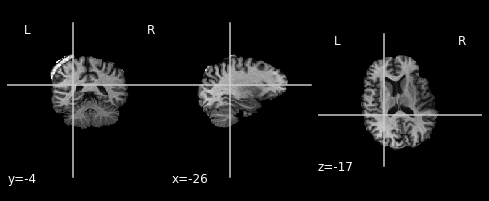
Create your own Python interface¶
CommandLine interface is great, but my tool is already in Python - can I wrap it natively?
Sure. Let’s solve the following problem: Let’s say we have a Python function that takes an input image and a list of three translations (x, y, z) in mm, and then writes a resampled image after the translation has been applied:
def translate_image(img, translation, out_file):
import nibabel as nb
import numpy as np
from scipy.ndimage.interpolation import affine_transform
# Load the data
nii = nb.load(img)
data = nii.get_fdata()
# Create the transformation matrix
matrix = np.eye(3)
trans = (np.array(translation) / nii.header.get_zooms()[:3]) * np.array([1.0, -1.0, -1.0])
# Apply the transformation matrix
newdata = affine_transform(data, matrix=matrix, offset=trans)
# Save the new data in a new NIfTI image
nb.Nifti1Image(newdata, nii.affine, nii.header).to_filename(out_file)
print('Translated file now is here: %s' % out_file)
Let’s see how this function operates:
orig_image = '/data/ds000114/sub-01/ses-test/anat/sub-01_ses-test_T1w.nii.gz'
translation = [20.0, -20.0, -20.0]
translated_image = 'translated.nii.gz'
# Let's run the translate_image function on our inputs
translate_image(orig_image,
translation,
translated_image)
Translated file now is here: translated.nii.gz
Now that the function was executed, let’s plot the original and the translated image.
plot_anat(orig_image, dim=-1);
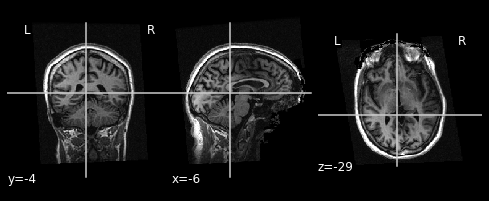
plot_anat('translated.nii.gz', dim=-1);
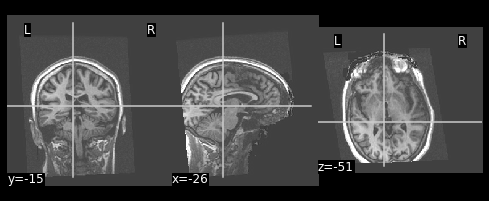
Perfect, we see that the translation was applied.
Quick approach - Function interface¶
Don’t reinvent the wheel if it’s not necessary. If like in this case, we have a well-defined function we want to run with Nipype, it is fairly easy to solve it with the Function interface:
from nipype.interfaces.utility import Function
my_python_interface = Function(
input_names=['img', 'translation', 'out_file'],
output_names=['out_file'],
function=translate_image
)
The arguments of translate_image should ideally be listed in the same order and with the same names as in the signature of the function. The same should be the case for the outputs. Finally, the Function interface takes a function input that is pointed to your python code.
Note: The inputs and outputs do not pass any kind of conformity checking: the function node will take any kind of data type for their inputs and outputs.
There are some other limitations to the Function interface when used inside workflows. Additionally, the function must be totally self-contained, since it will run with no global context. In practice, it means that all the imported modules and variables must be defined within the context of the function.
For more, check out the Function Node notebook.
Back to our Function interface. You can run it as any other interface object of Nipype:
# Set inputs
my_python_interface.inputs.img = '/data/ds000114/sub-01/ses-test/anat/sub-01_ses-test_T1w.nii.gz'
my_python_interface.inputs.translation = [-35.0, 35.0, 35.0]
my_python_interface.inputs.out_file = 'translated_functioninterface.nii.gz'
# Run the interface
result = my_python_interface.run()
Translated file now is here: translated_functioninterface.nii.gz
# Plot the result
plot_anat('translated_functioninterface.nii.gz', dim=-1);
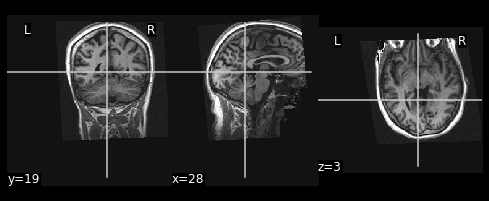
Complete approach - pure Python interface¶
Now, we face the problem of interfacing something different from a command line. Therefore, the CommandLine base class will not help us here. The specification of the inputs and outputs, though, will work the same way.
Let’s start from that point on. Our Python function takes in three inputs: (1) the input image, (2) the translation and (3) an output image.
The specification of inputs and outputs must be familiar to you at this point. Please note that now, input specification is derived from BaseInterfaceInputSpec, which is a bit thinner than CommandLineInputSpec. The output specification can be derived from TraitedSpec as before:
from nipype.interfaces.base import BaseInterfaceInputSpec, File, TraitedSpec
class TranslateImageInputSpec(BaseInterfaceInputSpec):
in_file = File(exists=True, mandatory=True, desc='the input image')
out_file = File(mandatory=True, desc='the output image') # Do not set exists=True !!
translation = traits.List([50.0, 0.0, 0.0], traits.Float, usedefault=True,
desc='the translation component of the input transform')
class TranslateImageOutputSpec(TraitedSpec):
out_file = File(desc='the output image')
Similarily to the change of base class for the input specification, the core of our new interface will derive from BaseInterface instead of CommandLineInterface:
from nipype.interfaces.base import BaseInterface
class TranslateImage(BaseInterface):
input_spec = TranslateImageInputSpec
output_spec = TranslateImageOutputSpec
At this point, we have defined a pure python interface but it is unable to do anything because we didn’t implement a _run_interface() method yet.
TranslateImage.help()
Inputs::
[Mandatory]
in_file: (a pathlike object or string representing an existing file)
the input image
out_file: (a pathlike object or string representing a file)
the output image
[Optional]
translation: (a list of items which are a float, nipype default
value: [50.0, 0.0, 0.0])
the translation component of the input transform
Outputs::
out_file: (a pathlike object or string representing a file)
the output image
What happens if we try to run such an interface without specifying the _run_interface() function?
will_fail_at_run = TranslateImage(
in_file='/data/ds000114/sub-01/ses-test/anat/sub-01_ses-test_T1w.nii.gz',
out_file='translated.nii.gz')
try:
result = will_fail_at_run.run()
except(NotImplementedError) as err:
print('It crashed with...')
print("NotImplementedError:", err)
else:
raise
It crashed with...
NotImplementedError:
So, let’s implement the missing part. As we would imagine, this needs to be very similar to what we did before with the TransformInfo interface:
class TranslateImage(BaseInterface):
input_spec = TranslateImageInputSpec
output_spec = TranslateImageOutputSpec
def _run_interface(self, runtime):
# Call our python code here:
translate_image(
self.inputs.in_file,
self.inputs.translation,
self.inputs.out_file
)
# And we are done
return runtime
If we run it know, our interface will get further:
half_works = TranslateImage(
in_file='/data/ds000114/sub-01/ses-test/anat/sub-01_ses-test_T1w.nii.gz',
out_file='translated_nipype.nii.gz')
try:
result = half_works.run()
except(NotImplementedError) as err:
print('It crashed with...')
print("NotImplementedError:", err)
else:
raise
Translated file now is here: translated_nipype.nii.gz
It crashed with...
NotImplementedError:
… but still, it crashes becasue we haven’t specified any _list_outputs() method. I.e. our python function is called, but the interface crashes when the execution arrives to retrieving the outputs.
Let’s fix that:
from nipype.interfaces.base import BaseInterfaceInputSpec, BaseInterface, File, TraitedSpec
class TranslateImageInputSpec(BaseInterfaceInputSpec):
in_file = File(exists=True, mandatory=True, desc='the input image')
out_file = File(mandatory=True, desc='the output image') # Do not set exists=True !!
translation = traits.List([50.0, 0.0, 0.0], traits.Float, usedefault=True,
desc='the translation component of the input transform')
class TranslateImageOutputSpec(TraitedSpec):
out_file = File(desc='the output image')
class TranslateImage(BaseInterface):
input_spec = TranslateImageInputSpec
output_spec = TranslateImageOutputSpec
def _run_interface(self, runtime):
# Call our python code here:
translate_image(
self.inputs.in_file,
self.inputs.translation,
self.inputs.out_file
)
# And we are done
return runtime
def _list_outputs(self):
return {'out_file': self.inputs.out_file}
Now, we have everything together. So let’s run it and visualize the output file.
this_works = TranslateImage(
in_file='/data/ds000114/sub-01/ses-test/anat/sub-01_ses-test_T1w.nii.gz',
out_file='translated_nipype.nii.gz')
result = this_works.run()
Translated file now is here: translated_nipype.nii.gz
plot_anat(result.outputs.out_file, dim=-1);
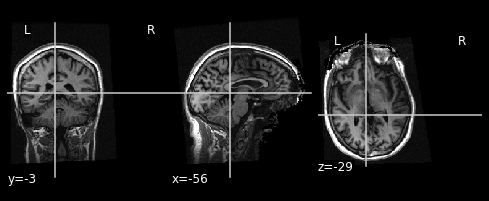
Create your own MATLAB interface¶
Last but not least, let’s take a look at how we would create a MATLAB interface. For this purpose, let’s say we want to run some matlab code that counts the number of voxels in an MRI image with intensity larger than zero. Such a value could give us an estimation of the brain volume (in voxels) of a skull-stripped image.
In MATLAB, our code looks as follows:
load input_image.mat;
total = sum(data(:) > 0)
The following example uses scipy.io.savemat to convert the input image to MATLAB format. Once the file is loaded we can quickly extract the estimated total volume.
Note: For the purpose of this example, we will be using the freely available MATLAB alternative Octave. But the implementation of a MATLAB interface will be identical.
Preparation¶
As before, we need to specify an InputSpec and an OutputSpec class. The input class will expect a file as an input and the script containing the code that we would like to run, and the output class will give us back the total volume.
In the context of a MATLAB interface, this is implemented as follows:
from nipype.interfaces.base import (CommandLine, traits, TraitedSpec,
BaseInterface, BaseInterfaceInputSpec, File)
class BrainVolumeMATLABInputSpec(BaseInterfaceInputSpec):
in_file = File(exists=True, mandatory=True)
script_file = File(exists=True, mandatory=True)
class BrainVolumeMATLABOutputSpec(TraitedSpec):
volume = traits.Int(desc='brain volume')
class BrainVolumeMATLAB(BaseInterface):
input_spec = BrainVolumeMATLABInputSpec
output_spec = BrainVolumeMATLABOutputSpec
Step by step implementation¶
Now, we have to specify what should happen, once the interface is run. As we said earlier, we want to:
load the image data and save it in a mat file
load the script
replace the put the relevant information into the script
run the script
extract the results
This all can be implemented with the following code:
# Specify the interface inputs
in_file = '/data/ds000114/sub-01/ses-test/anat/sub-01_ses-test_T1w.nii.gz'
script_file = '/home/neuro/workshop/nipype_tutorial/notebooks/scripts/brainvolume.m'
!cat scripts/brainvolume.m
load input_image.mat;
total = sum(data(:) > 0)
import re
import nibabel as nb
from scipy.io import savemat
# 1. save the image in matlab format as tmp_image.mat
tmp_image = 'tmp_image.mat'
data = nb.load(in_file).get_fdata()
savemat(tmp_image, {b'data': data}, do_compression=False)
# 2. load script
with open(script_file) as script_file:
script_content = script_file.read()
# 3. replace the input_image.mat file with the actual input of this interface
with open('newscript.m', 'w') as script_file:
script_file.write(script_content.replace('input_image.mat', 'tmp_image.mat'))
# 4. run the matlab script
mlab = CommandLine('octave', args='newscript.m', terminal_output='stream')
result = mlab.run()
211017-16:37:01,228 nipype.interface INFO:
stderr 2021-10-17T16:37:01.227641:octave: X11 DISPLAY environment variable not set
211017-16:37:01,232 nipype.interface INFO:
stderr 2021-10-17T16:37:01.227641:octave: disabling GUI features
211017-16:37:02,385 nipype.interface INFO:
stdout 2021-10-17T16:37:02.385092:total = 5308353
# 5. extract the volume estimation from the output
expr_tra = re.compile('total\ =\s+(?P<total>[0-9]+)')
volume = int(expr_tra.search(result.runtime.stdout).groupdict()['total'])
print(volume)
5308353
Putting it all together¶
Now we just need to put this all together in the _run_interface() method and add a _list_outputs() function:
from nipype.interfaces.base import (CommandLine, traits, TraitedSpec,
BaseInterface, BaseInterfaceInputSpec, File)
import re
import nibabel as nb
from scipy.io import savemat
class BrainVolumeMATLABInputSpec(BaseInterfaceInputSpec):
in_file = File(exists=True, mandatory=True)
script_file = File(exists=True, mandatory=True)
class BrainVolumeMATLABOutputSpec(TraitedSpec):
volume = traits.Int(desc='brain volume')
class BrainVolumeMATLAB(BaseInterface):
input_spec = BrainVolumeMATLABInputSpec
output_spec = BrainVolumeMATLABOutputSpec
def _run_interface(self, runtime):
# Save the image in matlab format as tmp_image.mat
tmp_image = 'tmp_image.mat'
data = nb.load(self.inputs.in_file).get_fdata()
savemat(tmp_image, {b'data': data}, do_compression=False)
# Load script
with open(self.inputs.script_file) as script_file:
script_content = script_file.read()
# Replace the input_image.mat file for the actual input of this interface
with open('newscript.m', 'w') as script_file:
script_file.write(script_content.replace('input_image.mat', 'tmp_image.mat'))
# Run a matlab command
mlab = CommandLine('octave', args='newscript.m', terminal_output='stream')
result = mlab.run()
expr_tra = re.compile('total\ =\s+(?P<total>[0-9]+)')
volume = int(expr_tra.search(result.runtime.stdout).groupdict()['total'])
setattr(self, '_result', volume)
return result.runtime
def _list_outputs(self):
outputs = self._outputs().get()
outputs['volume'] = getattr(self, '_result')
return outputs
Let’s test it:
matlab = BrainVolumeMATLAB(in_file='/data/ds000114/sub-01/ses-test/anat/sub-01_ses-test_T1w.nii.gz',
script_file='/home/neuro/workshop/nipype_tutorial/notebooks/scripts/brainvolume.m')
result = matlab.run()
211017-16:37:03,650 nipype.interface INFO:
stderr 2021-10-17T16:37:03.650423:octave: X11 DISPLAY environment variable not set
211017-16:37:03,654 nipype.interface INFO:
stderr 2021-10-17T16:37:03.650423:octave: disabling GUI features
211017-16:37:04,478 nipype.interface INFO:
stdout 2021-10-17T16:37:04.478099:total = 5308353
print(result.outputs)
volume = 5308353
We see in the example above that everything works fine. But now, let’s say that we want to save the total brain volume to a file and give the location of this file back as an output. How would you do that?
Exercise¶
Modify the BrainVolumeMATLAB interface so that it has one more output called out_file, that points to a text file where we write the volume in voxels. The name of the out_file can be hard coded to volume.txt.
# Write your solution here
from nipype.interfaces.base import (CommandLine, traits, TraitedSpec,
BaseInterface, BaseInterfaceInputSpec, File)
import os
import re
import nibabel as nb
from scipy.io import savemat
class BrainVolumeMATLABInputSpec(BaseInterfaceInputSpec):
in_file = File(exists=True, mandatory=True)
script_file = File(exists=True, mandatory=True)
class BrainVolumeMATLABOutputSpec(TraitedSpec):
volume = traits.Int(desc='brain volume')
out_file = File(desc='output file containing total brain volume') # This line was added
class BrainVolumeMATLAB(BaseInterface):
input_spec = BrainVolumeMATLABInputSpec
output_spec = BrainVolumeMATLABOutputSpec
def _run_interface(self, runtime):
# Save the image in matlab format as tmp_image.mat
tmp_image = 'tmp_image.mat'
data = nb.load(self.inputs.in_file).get_fdata()
savemat(tmp_image, {b'data': data}, do_compression=False)
# Load script
with open(self.inputs.script_file) as script_file:
script_content = script_file.read()
# Replace the input_image.mat file for the actual input of this interface
with open('newscript.m', 'w') as script_file:
script_file.write(script_content.replace('input_image.mat', 'tmp_image.mat'))
# Run a matlab command
mlab = CommandLine('octave', args='newscript.m', terminal_output='stream')
result = mlab.run()
expr_tra = re.compile('total\ =\s+(?P<total>[0-9]+)')
volume = int(expr_tra.search(result.runtime.stdout).groupdict()['total'])
setattr(self, '_result', volume)
# Write total brain volume into a file
out_fname = os.path.abspath('volume.txt')
setattr(self, '_out_file', out_fname)
with open('volume.txt', 'w') as out_file:
out_file.write('%d' %volume)
return result.runtime
def _list_outputs(self):
outputs = self._outputs().get()
outputs['volume'] = getattr(self, '_result')
outputs['out_file'] = getattr(self, '_out_file')
return outputs
Now, let’s test if it works.
matlab = BrainVolumeMATLAB(in_file='/data/ds000114/sub-01/ses-test/anat/sub-01_ses-test_T1w.nii.gz',
script_file='/home/neuro/workshop/nipype_tutorial/notebooks/scripts/brainvolume.m')
result = matlab.run()
211017-16:37:05,660 nipype.interface INFO:
stderr 2021-10-17T16:37:05.660099:octave: X11 DISPLAY environment variable not set
211017-16:37:05,662 nipype.interface INFO:
stderr 2021-10-17T16:37:05.660099:octave: disabling GUI features
211017-16:37:06,286 nipype.interface INFO:
stdout 2021-10-17T16:37:06.286014:total = 5308353
No errors, perfect. Did we get the right file?
print(result.outputs.out_file)
/home/neuro/workshop_weizmann/workshop/nipype/notebooks/volume.txt
And what about the content of this file?
!cat volume.txt
5308353
